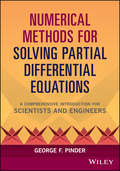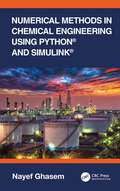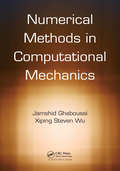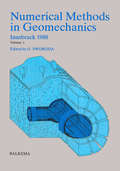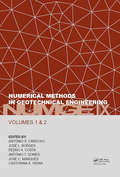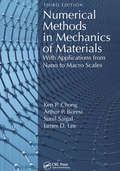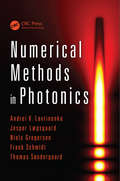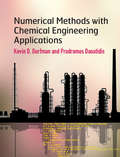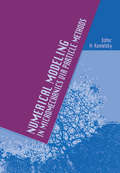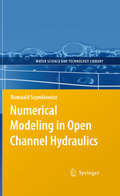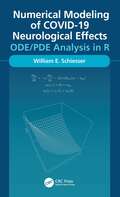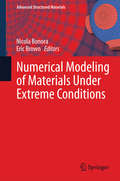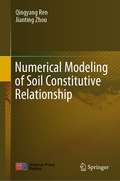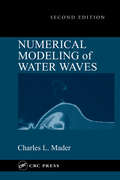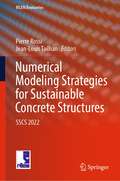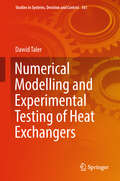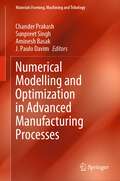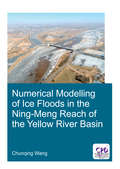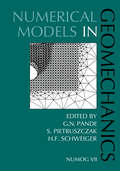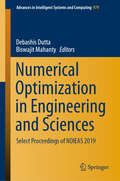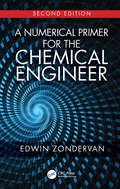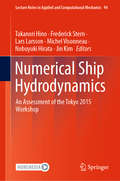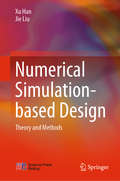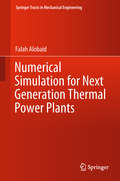- Table View
- List View
Numerical Methods for Solving Partial Differential Equations: A Comprehensive Introduction for Scientists and Engineers
by George F. PinderA comprehensive guide to numerical methods for simulating physical-chemical systems This book offers a systematic, highly accessible presentation of numerical methods used to simulate the behavior of physical-chemical systems. Unlike most books on the subject, it focuses on methodology rather than specific applications. Written for students and professionals across an array of scientific and engineering disciplines and with varying levels of experience with applied mathematics, it provides comprehensive descriptions of numerical methods without requiring an advanced mathematical background. Based on its author’s more than forty years of experience teaching numerical methods to engineering students, Numerical Methods for Solving Partial Differential Equations presents the fundamentals of all of the commonly used numerical methods for solving differential equations at a level appropriate for advanced undergraduates and first-year graduate students in science and engineering. Throughout, elementary examples show how numerical methods are used to solve generic versions of equations that arise in many scientific and engineering disciplines. In writing it, the author took pains to ensure that no assumptions were made about the background discipline of the reader. Covers the spectrum of numerical methods that are used to simulate the behavior of physical-chemical systems that occur in science and engineering Written by a professor of engineering with more than forty years of experience teaching numerical methods to engineers Requires only elementary knowledge of differential equations and matrix algebra to master the material Designed to teach students to understand, appreciate and apply the basic mathematics and equations on which Mathcad and similar commercial software packages are based Comprehensive yet accessible to readers with limited mathematical knowledge, Numerical Methods for Solving Partial Differential Equations is an excellent text for advanced undergraduates and first-year graduate students in the sciences and engineering. It is also a valuable working reference for professionals in engineering, physics, chemistry, computer science, and applied mathematics.
Numerical Methods in Chemical Engineering Using Python® and Simulink®
by Nayef GhasemNumerical methods are vital to the practice of chemical engineering, allowing for the solution of real-world problems. Written in a concise and practical format, this textbook introduces readers to the numerical methods required in the discipline of chemical engineering and enables them to validate their solutions using both Python and Simulink. Introduces numerical methods, followed by the solution of linear and nonlinear algebraic equations. Deals with the numerical integration of a definite function and solves initial and boundary value ordinary differential equations with different orders. Weaves in examples of various numerical methods and validates solutions to each with Python and Simulink graphical programming. Features appendices on how to use Python and Simulink. Aimed at advanced undergraduate and graduate chemical engineering students, as well as practicing chemical engineers, this textbook offers a guide to the use of two of the most widely used programs in the discipline. The textbook features numerous video lectures of applications and a solutions manual for qualifying instructors.
Numerical Methods in Computational Mechanics
by Jamshid Ghaboussi Xiping Steven WuThis book explores the numerical algorithms underpinning modern finite element based computational mechanics software. It covers all the major numerical methods that are used in computational mechanics. It reviews the basic concepts in linear algebra and advanced matrix theory, before covering solution of systems of equations, symmetric eigenvalue solution methods, and direct integration of discrete dynamic equations of motion, illustrated with numerical examples. This book suits a graduate course in mechanics based disciplines, and will help software developers in computational mechanics. Increased understanding of the underlying numerical methods will also help practicing engineers to use the computational mechanics software more effectively.
Numerical Methods in Engineering with Python 3
by Jaan KiusalaasThis book is an introduction to numerical methods for students in engineering. It covers the usual topics found in an engineering course: solution of equations, interpolation and data fitting, solution of differential equations, eigenvalue problems, and optimization. The algorithms are implemented in Python 3, a high-level programming language that rivals MATLAB® in readability and ease of use. All methods include programs showing how the computer code is utilized in the solution of problems. The book is based on Numerical Methods in Engineering with Python, which used Python 2. This new text demonstrates the use of Python 3 and includes an introduction to the Python plotting package Matplotlib. This comprehensive book is enhanced by the addition of numerous examples and problems throughout.
Numerical Methods in Geomechanics Volume 1: Innsbruck, 1988
by G. SwobodaFirst Published in 2017. Routledge is an imprint of Taylor & Francis, an Informa company.
Numerical Methods in Geotechnical Engineering IX: Proceedings of the 9th European Conference on Numerical Methods in Geotechnical Engineering (NUMGE 2018), June 25-27, 2018, Porto, Portugal
by António S. Cardoso, José L. Borges, Pedro A. Costa, António T. Gomes, José C. Marques & Castorina S. VieiraNumerical Methods in Geotechnical Engineering IX contains 204 technical and scientific papers presented at the 9th European Conference on Numerical Methods in Geotechnical Engineering (NUMGE2018, Porto, Portugal, 25—27 June 2018). The papers cover a wide range of topics in the field of computational geotechnics, providing an overview of recent developments on scientific achievements, innovations and engineering applications related to or employing numerical methods. They deal with subjects from emerging research to engineering practice, and are grouped under the following themes: Constitutive modelling and numerical implementation Finite element, discrete element and other numerical methods. Coupling of diverse methods Reliability and probability analysis Large deformation – large strain analysis Artificial intelligence and neural networks Ground flow, thermal and coupled analysis Earthquake engineering, soil dynamics and soil-structure interactions Rock mechanics Application of numerical methods in the context of the Eurocodes Shallow and deep foundations Slopes and cuts Supported excavations and retaining walls Embankments and dams Tunnels and caverns (and pipelines) Ground improvement and reinforcement Offshore geotechnical engineering Propagation of vibrations Following the objectives of previous eight thematic conferences, (1986 Stuttgart, Germany; 1990 Santander, Spain; 1994 Manchester, United Kingdom; 1998 Udine, Italy; 2002 Paris, France; 2006 Graz, Austria; 2010 Trondheim, Norway; 2014 Delft, The Netherlands), Numerical Methods in Geotechnical Engineering IX updates the state-of-the-art regarding the application of numerical methods in geotechnics, both in a scientific perspective and in what concerns its application for solving practical boundary value problems. The book will be much of interest to engineers, academics and professionals involved or interested in Geotechnical Engineering.
Numerical Methods in Mechanics of Materials: With Applications from Nano to Macro Scales
by Ken P. Chong Arthur P. Boresi Sunil Saigal James D. LeeIn the dynamic digital age, the widespread use of computers has transformed engineering and science. A realistic and successful solution of an engineering problem usually begins with an accurate physical model of the problem and a proper understanding of the assumptions employed. With computers and appropriate software we can model and analyze complex physical systems and problems. However, efficient and accurate use of numerical results obtained from computer programs requires considerable background and advanced working knowledge to avoid blunders and the blind acceptance of computer results. This book provides the background and knowledge necessary to avoid these pitfalls, especially the most commonly used numerical methods employed in the solution of physical problems. It offers an in-depth presentation of the numerical methods for scales from nano to macro in nine self-contained chapters with extensive problems and up-to-date references, covering: Trends and new developments in simulation and computation Weighted residuals methods Finite difference methods Finite element methods Finite strip/layer/prism methods Boundary element methods Meshless methods Molecular dynamics Multiphysics problems Multiscale methods
Numerical Methods in Photonics (Optical Sciences and Applications of Light #1)
by Niels Gregersen Andrei V. Lavrinenko Jesper Lægsgaard Frank Schmidt Thomas SøndergaardSimulation and modeling using numerical methods is one of the key instruments in any scientific work. In the field of photonics, a wide range of numerical methods are used for studying both fundamental optics and applications such as design, development, and optimization of photonic components. Modeling is key for developing improved photonic devices and reducing development time and cost. Choosing the appropriate computational method for a photonics modeling problem requires a clear understanding of the pros and cons of the available numerical methods. Numerical Methods in Photonics presents six of the most frequently used methods: FDTD, FDFD, 1+1D nonlinear propagation, modal method, Green’s function, and FEM. After an introductory chapter outlining the basics of Maxwell’s equations, the book includes self-contained chapters that focus on each of the methods. Each method is accompanied by a review of the mathematical principles in which it is based, along with sample scripts, illustrative examples of characteristic problem solving, and exercises. MATLAB® is used throughout the text. This book provides a solid basis to practice writing your own codes. The theoretical formulation is complemented by sets of exercises, which allow you to grasp the essence of the modeling tools.
Numerical Methods with Chemical Engineering Applications
by Kevin D. Dorfman Prodromos DaoutidisDesigned primarily for undergraduates, but also graduates and practitioners, this textbook integrates numerical methods and programming with applications from chemical engineering. Combining mathematical rigor with an informal writing style, it thoroughly introduces the theory underlying numerical methods, its translation into MATLAB programs, and its use for solving realistic problems. Specific topics covered include accuracy, convergence and numerical stability, as well as stiffness and ill-conditioning. MATLAB codes are developed from scratch, and their implementation is explained in detail, all while assuming limited programming knowledge. All scripts employed are downloadable, and built-in MATLAB functions are discussed and contextualised. Numerous examples and homework problems - from simple questions to extended case studies - accompany the text, allowing students to develop a deep appreciation for the range of real chemical engineering problems that can be solved using numerical methods. This is the ideal resource for a single-semester course on numerical methods, as well as other chemical engineering courses taught over multiple semesters.
Numerical Modeling in Micromechanics via Particle Methods: International PFC Symposium, Gelsenkirchen, Germany, 6-8 November 2002
by H. KonietzkyParticle methods have seen increasing use in several engineering and scientific fields, both because of their unique modelling capabilities and the availability of the necessary computational power. This title focuses on their theory and application.
Numerical Modeling in Open Channel Hydraulics
by Romuald SzymkiewiczThis book offers a comprehensive approach to the numerical modeling of open channel flow, based on the author's own research in this field, as well as his experience as a lecturer. It provides the reader with: Coverage of the most important problems of open channel hydraulics, including steady and unsteady flow in a single channel and in a channel network, transport of dissolved substance, transport of energy and more;Unified derivation of the governing equations for all problems, based on the fundamental laws of mass, momentum and energy conservation;Comprehensive presentation of the numerical methods applied in open channel flow modeling, with particular regard to the solution of hyperbolic and parabolic partial differential equations, which govern many important flow and transport processes;Detailed description of the numerical algorithms applied to solve particular problems, with many examples of solutions; Accuracy analysis of the numerical algorithms using the modified equation approach; New insights into numerical solution of some classical problems of open channel hydraulics, e.g. steady varied flow in a channel of arbitrary geometry.In-depth analysis of the simplified flood routing models and their unphysical properties, including a proposition of an alternative Instantaneous Unit Hydrograph, valid for all simplified models.Written in an accessible language, Numerical Modeling in Open Channel Hydraulics contains information useful for higher level undergraduate and postgraduate students of civil and environmental engineering faculties, as well as scientists and practitioners in the field of hydraulic engineering, especially those using existing numerical codes or developing their own ones.
Numerical Modeling of COVID-19 Neurological Effects: ODE/PDE Analysis in R
by William SchiesserCovid-19 is primarily a respiratory disease which results in impaired oxygenation of blood. The O2-deficient blood then moves through the body, and for the study in this book, the focus is on the blood flowing to the brain. The dynamics of blood flow along the brain capillaries and tissue is modeled as systems of ordinary and partial differential equations (ODE/PDEs). The ODE/PDE methodology is presented through a series of examples, 1. A basic one PDE model for O2 concentration in the brain capillary blood. 2. A two PDE model for O2 concentration in the brain capillary blood and in the brain tissue, with O2 transport across the blood brain barrier (BBB). 3. The two model extended to three PDEs to include the brain functional neuron cell density. Cognitive impairment could result from reduced neuron cell density in time and space (in the brain) that follows from lowered O2 concentration (hypoxia). The computer-based implementation of the example models is presented through routines coded (programmed) in R, a quality, open-source scientific computing system that is readily available from the Internet. Formal mathematics is minimized, e.g., no theorems and proofs. Rather, the presentation is through detailed examples that the reader/researcher/analyst can execute on modest computers. The PDE analysis is based on the method of lines (MOL), an established general algorithm for PDEs, implemented with finite differences. The routines are available from a download link so that the example models can be executed without having to first study numerical methods and computer coding. The routines can then be applied to variations and extensions of the blood/brain hypoxia models, such as changes in the ODE/PDE parameters (constants) and form of the model equations.
Numerical Modeling of Materials Under Extreme Conditions
by Nicola Bonora Eric BrownThe book presents twelve state of the art contributions in the field of numerical modeling of materials subjected to large strain, high strain rates, large pressure and high stress triaxialities, organized into two sections. The first part is focused on high strain rate-high pressures such as those occurring in impact dynamics and shock compression related phenomena, dealing with material response identification, advanced modeling incorporating microstructure and damage, stress waves propagation in solids and structures response under impact. The latter part is focused on large strain-low strain rates applications such as those occurring in technological material processing, dealing with microstructure and texture evolution, material response at elevated temperatures, structural behavior under large strain and multi axial state of stress.
Numerical Modeling of Soil Constitutive Relationship
by Qingyang Ren Jianting ZhouThis book adopts numerical method to model soil constitutive relationship while it abandons the traditional idea of looking for plastic potential as the only way to model. Firstly, the triaxial compression tests of expansive soil, sand and clay under different stress paths are introduced; then the elastoplastic constitutive equations of expansive soil, sand and clay under various stress paths are established by numerical modeling method; finally, the constitutive equations are embedded in the finite element program and verified by comparing the finite element calculation results of the triaxial test soil samples with the corresponding test results. The modeling obtains high accuracy.
Numerical Modeling of Water Waves
by Charles L. MaderNumerical Modeling of Water Waves, Second Edition covers all aspects of this subject, from the basic fluid dynamics and the simplest models to the latest and most complex, including the first-ever description of techniques for modeling wave generation by explosions, projectile impacts, asteroids, and impact landslides. The book comes packaged with
Numerical Modeling Strategies for Sustainable Concrete Structures: SSCS 2022 (RILEM Bookseries #38)
by Pierre Rossi Jean-Louis TailhanThis volume highlights the latest advances, innovations, and applications in the field of sustainable concrete structures, as presented by scientists and engineers at the RILEM International Conference on Numerical Modeling Strategies for Sustainable Concrete Structures (SSCS), held in Marseille, France, on July 4-6, 2022. It demonstrates that numerical methods (finite elements, finite volumes, finite differences) are a relevant response to the challenge to optimize the utilization of cement in concrete constructions while checking that these constructions have a lifespan compatible with the stakes of sustainable development. They are indeed accurate tools for an optimized design of concrete constructions, and allow us to consider all types of complexities: for example, those linked to rheological, physicochemical and mechanical properties of concrete, those linked to the geometry of the structures or even to the environmental boundary conditions. This optimization must also respect constraints of time, money, security, energy, CO2 emissions, and, more generally, life cycle more reliably than the codes and analytical approaches currently used. Numerical methods are, undoubtedly, the best calculation tools at the service of concrete eco-construction. The contributions present traditional and new ideas that will open novel research directions and foster multidisciplinary collaboration between different specialists.
Numerical Modelling and Experimental Testing of Heat Exchangers (Studies in Systems, Decision and Control #161)
by Dawid TalerThis book presents new methods of numerical modelling of tube heat exchangers, which can be used to perform design and operation calculations of exchangers characterized by a complex flow system. It also proposes new heat transfer correlations for laminar, transition and turbulent flows. A large part of the book is devoted to experimental testing of heat exchangers, and methods for assessing the indirect measurement uncertainty are presented. Further, it describes a new method for parallel determination of the Nusselt number correlations on both sides of the tube walls based on the nonlinear least squares method and presents the application of computational fluid dynamic (CFD) modeling to determine the air-side Nusselt number correlations. Lastly, it develops a control system based on the mathematical model of the car radiator and compares this with the digital proportional-integral-derivative (PID) controller. The book is intended for students, academics and researchers, as well as for designers and manufacturers of heat exchangers.
Numerical Modelling and Optimization in Advanced Manufacturing Processes (Materials Forming, Machining and Tribology)
by Chander Prakash Sunpreet Singh Aminesh Basak J. Paulo DavimThis book presents different numerical modeling and nature-inspired optimization methods in advanced manufacturing processes for understanding the process characteristics. Particular emphasis is devoted to applications in non-conventional machining, nano-finishing, precision casting, porous biofabrication, three-dimensional printing, and micro-/nanoscale modeling. The book includes practical implications of empirical, analytical, and numerical models for predicting the vital output responses. Especial attention is given to finite element methods (FEMs) for understanding the design of novel highly complex engineering products, their performances, and behaviors under simulated processing conditions.
Numerical Modelling of Ice Floods in the Ning-Meng Reach of the Yellow River Basin (IHE Delft PhD Thesis Series)
by Chunqing WangThe Ning-Meng reach of the Yellow River basin is located in the Inner Mongolia region at the Northern part of the Yellow River. Due to the special geographical conditions, the river flow direction is towards the North causing the Ning-Meng reach to freeze up every year in wintertime. Both during the freeze-up and break-up period, unfavourable conditions occur which may cause ice jamming and ice dam formation leading to dike breaching and overtopping of the embankment. Throughout history this has often led to considerable casualties and property loss. Enhanced economic development and human activities in the region have altered the characteristics of the ice regime in recent decades, leading to several ice disasters during freezing or breaking-up periods. The integrated water resources management plan developed by the Yellow River Conservancy Commission (YRCC) outlines the requirements for water regulation in the upper Yellow River during ice flood periods. YRCC is developing measures that not only safeguard against ice floods, but also assure the availability of adequate water resources. These provide the overall requirements for developing an ice regime forecasting system including lead-time prediction and required accuracy. In order to develop such a system, numerical modelling of ice floods is an essential component of current research at the YRCC, together with field observations and laboratory experiments. In order to properly model river ice processes it is necessary to adjust the hydrodynamic equations to account for thermodynamic effects. In this research, hydrological and meteorological data from 1950 to 2010 were used to analyse the characteristics of ice regimes in the past. Also, additional field observations were carried out for ice flood model calibration and validation. By combining meteorological forecasting models with statistical models, a medium to short range air temperature forecasting model for the Ning-Meng reach was established. These results were used to improve ice formation modelling and prolong lead-time prediction. The numerical ice flood model developed in this thesis for the Ning-Meng reach allows better forecasting of the ice regime and improved decision support for upstream reservoir regulation and taking appropriate measures for disaster risk reduction.
Numerical Models in Geomechanics: Proceedings Of The Tenth International Symposium On Numerical Models In Geomechanics (numog X), Rhodes, Greece, 25-27 April 2007
by G. N. PandeIn this volume a number of developments on a variety of topics have been reported. These topics include: partially saturated soil; instabilities in soil behaviour; environmental geomechanics; parallel computing; and applications to tunnels, embankments, slopes, foundations and anchors.
Numerical Optimization in Engineering and Sciences: Select Proceedings of NOIEAS 2019 (Advances in Intelligent Systems and Computing #979)
by Debashis Dutta Biswajit MahantyThis book presents select peer-reviewed papers presented at the International Conference on Numerical Optimization in Engineering and Sciences (NOIEAS) 2019. The book covers a wide variety of numerical optimization techniques across all major engineering disciplines like mechanical, manufacturing, civil, electrical, chemical, computer, and electronics engineering. The major focus is on innovative ideas, current methods and latest results involving advanced optimization techniques. The contents provide a good balance between numerical models and analytical results obtained for different engineering problems and challenges. This book will be useful for students, researchers, and professionals interested in engineering optimization techniques.
A Numerical Primer for the Chemical Engineer, Second Edition
by Edwin ZondervanDesigned as an introduction to numerical methods for students, this book combines mathematical correctness with numerical performance, and concentrates on numerical methods and problem solving. It applies actual numerical solution strategies to formulated process models to help identify and solve chemical engineering problems. Second edition comes with additional chapter on numerical integration and section on boundary value problems in the relevant chapter. Additional material on general modelling principles, mass/energy balances and separate section on DAE’s is also included. Case study section has been extended with additional examples.
Numerical Ship Hydrodynamics: An Assessment of the Tokyo 2015 Workshop (Lecture Notes in Applied and Computational Mechanics #94)
by Takanori Hino Frederick Stern Lars Larsson Michel Visonneau Nobuyuki Hirata Jin KimThis book explores computational fluid dynamics applied to ship hydrodynamics and provides guidelines for the future developments in the field based on the Tokyo 2015 Workshop. It presents ship hull test cases, experimental data and submitted computational methods, conditions, grids and results. Analysis is made of errors for global (resistance, sinkage, trim and self-propulsion) and local flow (wave elevations, mean velocities and turbulence) variables, including standard deviations for global variables. The effects of grid size and turbulence models are evaluated for both global and local flow variables. Detailed analysis is made of turbulence modeling capabilities for capturing local flow physics. Errors and standard deviations are also assessed for added resistance (captive test cases) and course keeping/speed loss (free running test cases) in head and oblique waves. All submissions are used to evaluate the error and uncertainty by means of a systematic verification and validation (V&V) study along with statistical investigations.
Numerical Simulation-based Design: Theory and Methods
by Xu Han Jie LiuThis book focuses on numerical simulation-based design theory and methods inmechanical engineering. The simulation-based design of mechanical equipmentinvolves considerable scientific challenges including extremely complex systems,extreme working conditions, multi-source uncertainties, multi-physics coupling, andlarge-scale computation. In order to overcome these technical difficulties, this booksystematically elaborates upon the advanced design methods, covering high-fidelitysimulation modeling, rapid structural analysis, multi-objective design optimization,uncertainty analysis and optimization, which can effectively improve the designaccuracy, efficiency, multi-functionality and reliability of complicated mechanicalstructures.This book is primarily intended for researchers, engineers and postgraduate studentsin mechanical engineering, especially in mechanical design, numerical simulation andengineering optimization.
Numerical Simulation for Next Generation Thermal Power Plants (Springer Tracts in Mechanical Engineering)
by Falah AlobaidThe book provides highly specialized researchers and practitioners with a major contribution to mathematical models’ developments for energy systems. First, dynamic process simulation models based on mixture flow and two-fluid models are developed for combined-cycle power plants, pulverised coal-fired power plants, concentrated solar power plant and municipal waste incineration. Operation data, obtained from different power stations, are used to investigate the capability of dynamic models to predict the behaviour of real processes and to analyse the influence of modeling assumptions on simulation results. Then, a computational fluid dynamics (CFD) simulation programme, so-called DEMEST, is developed. Here, the fluid-solid, particle-particle and particle-wall interactions are modeled by tracking all individual particles. To this purpose, the deterministic Euler-Lagrange/Discrete Element Method (DEM) is applied and further improved. An emphasis is given to the determination of inter-phase values, such as volumetric void fraction, momentum and heat transfers, using a new procedure known as the offset-method and to the particle-grid method allowing the refinement of the grid resolution independently from particle size. Model validation is described in detail. Moreover, thermochemical reaction models for solid fuel combustion are developed based on quasi-single-phase, two-fluid and Euler-Lagrange/MP-PIC models. Measurements obtained from actual power plants are used for validation and comparison of the developed numerical models.
